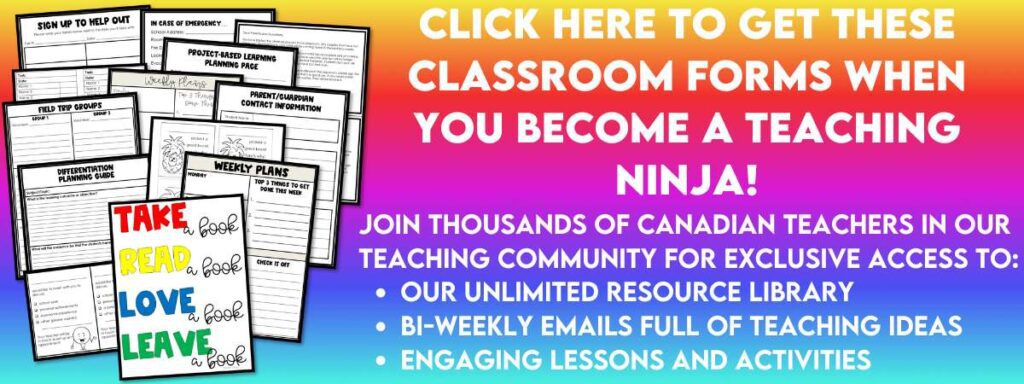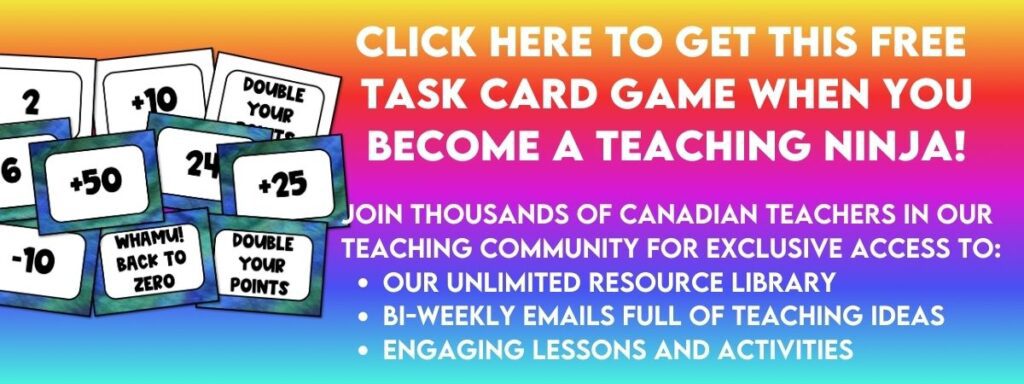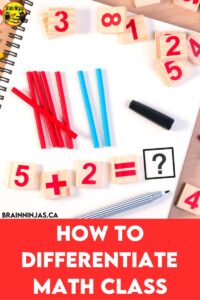
Differentiated instruction is expected of most classroom teachers these days. Long gone are the times when one worksheet could be given to every member of the class and they would all work on that page until every question was done correctly. Since the pandemic began, the once manageable (pause for laughter here) learning gaps between students have gotten even worse. So what is a teacher to do when there are such vast differences in skill levels during math class? How do you differentiate math lessons?
Every Class Has Different Grade Levels
There is no such thing as a classroom where every single student is able to do every single subject at the exact same level. The myth that all students used to learn the same way is also complete garbage. The truth is that back in the twentieth century, students who did not meet expectations were left behind by their peers. Those students regularly left school early or were placed in institutions.
Teaching combined grade levels for years has given us ninjas a unique perspective on the wide range of skills and abilities that students can possess. There is no one-size-fits-all, especially in math class. We have learned to differentiate efficiently because who has time to make thirty different lesson plans? These are our tried and true methods for differentiating math class in a pinch. (But it does take a little planning and organization to get there).
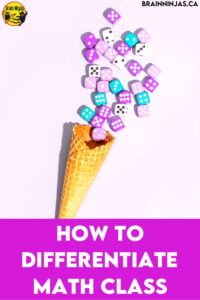
Whole Class Instruction
The first step in teaching a lesson. This lesson is designed to be the grade level in which students are enrolled. Because math is a spiral subject where students continually return to the same concept and then add complexity, we teach the whole class when we teach big ideas.
For example, addition is a big idea. We teach the whole class how to add multi-digit numbers. We start with a number example for the lowest skill in the class. So, for some students, this will be new information. For other students, this will be review. Then, we add a digit. For the students that this is too difficult, show them how to take off the extra digit (or ask them to challenge themselves). Keep adding a digit until you are all the way at the top of the grade level (or beyond if you want to challenge your students).
We follow these basic steps: teach, practice, play, and assess. Think of it as “I do,” we do,” and “you do.”
Students will practice their skill level through the other activities. They are assessed at their grade level of enrolment. As students are practicing, your role is to informally assess (How are they doing? What do they need assistance with? Are they ready to be formally assessed)?
Use Interactive Units
We use our interactive math units for our instruction. They come with the lessons, student templates, practice pages, games and assessments all in one place. All of the lessons include the grade level concepts but can easily be differentiated higher or lower as needed for your students.
Find the Grade 3 Interactive Unit Bundle on TpT ($USD) or our BN Shop ($CAN).
The Grade 4 Interactive Unit Bundle can be found on TpT ($USD) or our BN Shop ($CAN).
Our Grade 4/5 Interactive Unit Bundle includes both grade levels but can also be used for a combined classroom. Find it on TpT ($USD) or our BN Shop ($CAN).
Find the Grade 5 Interactive Unit Bundle on TpT ($USD) or our BN Shop ($CAN).
We also have a Grade 5/6 Interactive Unit Bundle, which includes the outcomes for both grade 5 and grade 6 and works for a combined class. Find it on TpT ($USD) or our BN Shop ($CAN).
The Grade 6 Interactive Unit Bundle can be found on TpT ($USD) or our BN Shop ($CAN).
Small Group Instruction
Sometimes, you’ll have small groups of students who need help with a specific concept. Small group work can have a significant impact on your instruction. It allows you to refine steps for students and work in a small setting where specific student needs can be personalized. This can include explicit instruction of a concept, reviewing procedures, or offering support using tools (like manipulatives, charts or lists) to work toward independence. Students may be more open to getting help if they see that all the students in your class work in small groups occasionally (as opposed to only the “dumb” kids needing help.
Use small group instruction to check in with students who may need a challenge. Select greater numbers, use algorithms that are more complex or find math puzzles that are more complex. Math Kangaroo is a Canadian math contest worth checking out.
Same Task, but Different Tools
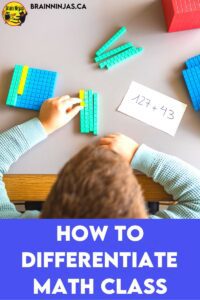
Sometimes, students can do the task but need a different tool in order to work independently. This could be manipulatives, a chart or table, graph paper, a ruler, lines on a page, a list of the steps, or anything else your students need. These tools may or may not be required for mastery, but during the learning phase of a new concept, the tools will help all that new learning stick.
There is often a misconception that providing tools makes the work easier. It doesn’t. It makes learning accessible. Most students are able to move beyond the tools, but tools are designed to help. If a student required eyeglasses to see the numbers on the page, would you take them away once they learned how to do it? Does having glasses make the work easier? Or does it make the work accessible?
Teach all your students about the different tools and let them try different ones out. They’ll learn what helps and what is a distraction. The students who truly need the help will feel more comfortable if they are offered to everyone. The stigma of needing help is lessened when even the “smart kids” use them.
Some of our favourite math manipulatives are Base 10 blocks, fraction pieces, number lines, measuring tools, graph paper (great for lining up place values) and place value charts. No budget? We use this virtual math manipulative site called Toy Theatre all the time!
Similar Task with Different Questions
Sometimes, the differentiation is as simple (translated as more work) as changing the questions. This might mean different students have different numbers of digits, but all students are working on addition.
We use colour coding for different grade levels, but generally, we try to make it less obvious. This keeps students from feeling like they are doing the “easy” or the “hard” work.
For example, everyone has the same answer page, but we’ve hidden blue task cards and yellow task cards around the room. Students are told which colour is easier and which is more difficult. They are asked to complete 5 of the most difficult questions they can find. Students add a B or Y to the box so you know which one they completed. If they completed the easier questions, send them to complete five of the more difficult ones “as a challenge” or because that’s their grade level. If they answered the more difficult ones wrong, ask them to try the other colour.
Keep track of the level of difficulty and the number correct on a class list. An editable name checklist can be found in our Resource Library, along with many other general classroom forms to help you organize your classroom. Or we can send it directly to your inbox when you sign up for our email list.
Use Task Cards
We love using task cards because it makes it SO easy to have students working on different levels at the same time. Our task card sets come with three different sets in each. They can be printed and placed around the classroom, but we’ve also included digital versions. One digital version uses Google Slides, where students can answer on the cards or on a piece of paper. The other digital version uses Google Forms and it will check the answers for you. So, this means you can assess your students at the same time, and every student could hypothetically be answering a different set of questions. Talk about easy for you!
Check out our task card bundles. Our bundles are growing, with new concepts being added all the time. Find them on TpT ($USD) or our BN Shop ($CAN).
Learn more about how we use task cards in the classroom in our post: The Trouble With Task Cards and How to Fix It.
Play Games
If you like to use paper task cards and want to turn them into a game, you should play Whamu! It’s a game designed by our students, and it’s just plain random and silly. You can find it in our Resource Library, or we can send it directly to your inbox.
If you have lots of worksheets around, turn them into easy games. We wrote an entire post called Math Worksheet Games Your Students Will Love.
English Language Learners

Students who are learning English often find math easier than other subjects because the symbols are the same in any language. They may need assistance with the instructions and avoid word problems until their language is strong enough. Small group work helps in these situations.
Use visual charts hung around the room that show the steps for algorithms. This helps everyone. Lots of students in your class can use a great reference anchor chart. Have the students create the anchor charts with you so they understand all the images. If you have limited wall space, take a photo of the chart and make photocopies for your students to keep in their interactive math journals.
Everyone Loves Manipulatives – Even Big Kids
A teacher I worked with taught grade six and said she didn’t use the Base 10 blocks in her room anymore, so I could have them. I jumped on it, but then I wanted to know why she didn’t use them. She said the kids were too old for them.
What?!
You are never too old for a concrete representation of a concept. I didn’t understand algebra at all through high school. I also didn’t understand it in university. It was like my brain had an algebra hole where that part just didn’t work.
Then, during my education degree, we were introduced to algebra tiles during a math methods course. For the first time in my life, I understood what I was doing AND I could explain it to others.
There is no such thing as “too old” for manipulatives. It is a powerful visual to build one million out of Base 10 blocks (and it takes about 45 minutes and a lot of masking tape so they don’t fall apart).
Get out those Base 10 blocks, fraction pieces, clocks, algebra tiles, place value charts, and anything else that can help your students make the learning connect in their brains.
You Need These Two Things to Differentiate Your Math Class

Classroom Management
You cannot work with small groups or individual students if the rest of your students cannot work independently for a few minutes. This is a skill that your students need to learn. We could write a whole other post about how to do this in math class, but we have an example of how to teach students to work independently in this post for guided reading. It applies to any time you are working with small groups while other students have to work on their own. Read Help! What Do the Other Kids Do During Guided Reading?
Planning and Organization
You need to know what your students need in order for things to run smoothly. This means having your lessons, worksheets, task cards, manipulatives or anything else you need ready to go.
We have this differentiation planning guide. By thinking about the needs of your students before your lesson, you’ll be able to plan for all the different types of learning. You can find this differentiation planning guide in our Resource Library, or we can send it directly to your inbox, along with some other classroom forms.
Review, Repeat, Reassess
This is a constant spiral cycle. Once you teach a concept and assess it, some students will have mastered it independently, some will need a little guidance, and some won’t even be close. That’s normal. You can return to the concept throughout the year. In fact, that’s math.
So, go on to the next concept, but continually review the previous ones. This is where using the interactive notebooks is so helpful. Students always have all their tools and will slowly become less dependent. They’ll be able to see connections between concepts.
Remember that you teach students math all year, so that might mean they master concepts at different points in the school year. What are some ways you differentiate math? Leave us a comment below to share your thoughts.
Teaching Math?
You might find these posts helpful.
Conquer Math With These Proven Multiplication Strategies
The Truth About New Math
How to Change Math With Interactive Notebooks
How to Use Interactive Notebooks to Teach Number Sense
Ways to Teach Shape and Space Concepts
How to Teach Students to Analyze Errors in Math
How to Help Your Students Master Decimal Operations
How to Teach Successful Long Division Strategies
How to Make Teaching Patterns Painless
Ways to Teach Classifying Triangles
How to Teach Rounding Numbers

